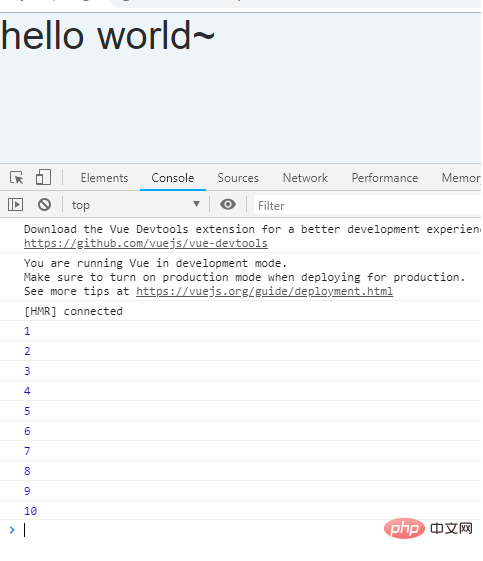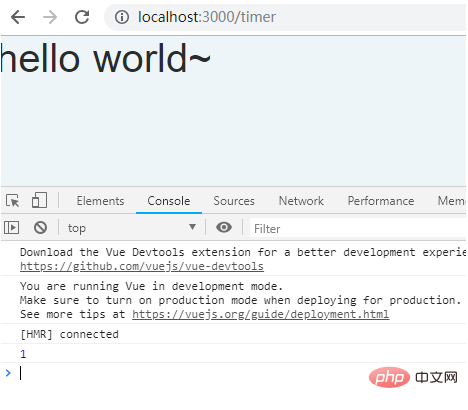How to use timer in vue.js
Methods for using timers in vue.js: 1. Use a loop to execute setInterval. This method will be executed every time until the timer is destroyed; 2. Execute setTimeout regularly and execute setTimeout regularly. It is to set a time and only execute it once when the waiting time is reached.

【Related article recommendations: vue.js】
Used in vue.js Timer method:
1. Loop execution (setInterval)
As the name suggests, loop execution is to set a time interval, which will be executed every time This method, until the timer is destroyed
The usage is setInterval ("method name or method", "delay"), the first parameter is the method name or method, be careful not to use it when it is the method name Add brackets, the second parameter is the time interval
<template>
<section>
<h1 id="hello-nbsp-world">hello world~</h1>
</section>
</template>
<script>
export default {
data() {
return {
timer: '',
value: 0
};
},
methods: {
get() {
this.value ++;
console.log(this.value);
}
},
mounted() {
this.timer = setInterval(this.get, 1000);
},
beforeDestroy() {
clearInterval(this.timer);
}
};
</script>
The above example is to create a timer setInterval when the page is initialized, the time interval is 1 second, every second The function get will be called once, thereby increasing the value of value by one.
2. Scheduled execution (setTimeout)
Scheduled execution setTimeout is to set a time. When the waiting time arrives, it is only executed once, but the timer is still there after execution. , but it is not running.
The usage is setTimeout("method name or method", "delay"); The first parameter is the method name or method. Be careful not to add parentheses when it is the method name. The second parameter is The parameter is the time interval
<template>
<section>
<h1 id="hello-nbsp-world">hello world~</h1>
</section>
</template>
<script>
export default {
data() {
return {
timer: '',
value: 0
};
},
methods: {
get() {
this.value ++;
console.log(this.value);
}
},
mounted() {
this.timer = setTimeout(this.get, 1000);
},
beforeDestroy() {
clearTimeout(this.timer);
}
};
</script>
The above is to create a timer setTimeout when the page is initialized, and only execute the method once after 1 second.
Related free learning recommendations: JavaScript (video)
The above is the detailed content of How to use timer in vue.js. For more information, please follow other related articles on the PHP Chinese website!

Hot AI Tools

Undresser.AI Undress
AI-powered app for creating realistic nude photos

AI Clothes Remover
Online AI tool for removing clothes from photos.

Undress AI Tool
Undress images for free

Clothoff.io
AI clothes remover

AI Hentai Generator
Generate AI Hentai for free.

Hot Article

Hot Tools

Notepad++7.3.1
Easy-to-use and free code editor

SublimeText3 Chinese version
Chinese version, very easy to use

Zend Studio 13.0.1
Powerful PHP integrated development environment

Dreamweaver CS6
Visual web development tools

SublimeText3 Mac version
God-level code editing software (SublimeText3)

Hot Topics
 Let's talk in depth about reactive() in vue3
Jan 06, 2023 pm 09:21 PM
Let's talk in depth about reactive() in vue3
Jan 06, 2023 pm 09:21 PM
Foreword: In the development of vue3, reactive provides a method to implement responsive data. This is a frequently used API in daily development. In this article, the author will explore its internal operating mechanism.
 Detailed graphic explanation of how to integrate the Ace code editor in a Vue project
Apr 24, 2023 am 10:52 AM
Detailed graphic explanation of how to integrate the Ace code editor in a Vue project
Apr 24, 2023 am 10:52 AM
Ace is an embeddable code editor written in JavaScript. It matches the functionality and performance of native editors like Sublime, Vim, and TextMate. It can be easily embedded into any web page and JavaScript application. Ace is maintained as the main editor for the Cloud9 IDE and is the successor to the Mozilla Skywriter (Bespin) project.
 Explore how to write unit tests in Vue3
Apr 25, 2023 pm 07:41 PM
Explore how to write unit tests in Vue3
Apr 25, 2023 pm 07:41 PM
Vue.js has become a very popular framework in front-end development today. As Vue.js continues to evolve, unit testing is becoming more and more important. Today we’ll explore how to write unit tests in Vue.js 3 and provide some best practices and common problems and solutions.
 What is the difference between componentization and modularization in vue
Dec 15, 2022 pm 12:54 PM
What is the difference between componentization and modularization in vue
Dec 15, 2022 pm 12:54 PM
The difference between componentization and modularization: Modularization is divided from the perspective of code logic; it facilitates code layered development and ensures that the functions of each functional module are consistent. Componentization is planning from the perspective of UI interface; componentization of the front end facilitates the reuse of UI components.
 In-depth discussion of how vite parses .env files
Jan 24, 2023 am 05:30 AM
In-depth discussion of how vite parses .env files
Jan 24, 2023 am 05:30 AM
When using the Vue framework to develop front-end projects, we will deploy multiple environments when deploying. Often the interface domain names called by development, testing and online environments are different. How can we make the distinction? That is using environment variables and patterns.
 Analyze the principle of Vue2 implementing composition API
Jan 13, 2023 am 08:30 AM
Analyze the principle of Vue2 implementing composition API
Jan 13, 2023 am 08:30 AM
Since the release of Vue3, the word composition API has entered the field of vision of students who write Vue. I believe everyone has always heard how much better the composition API is than the previous options API. Now, due to the release of the @vue/composition-api plug-in, Vue2 Students can also get on the bus. Next, we will mainly use responsive ref and reactive to conduct an in-depth analysis of how this plug-in achieves this.
 Detailed example of vue3 realizing the typewriter effect of chatgpt
Apr 18, 2023 pm 03:40 PM
Detailed example of vue3 realizing the typewriter effect of chatgpt
Apr 18, 2023 pm 03:40 PM
When I was working on the chatgpt mirror site, I found that some mirror sites did not have typewriter cursor effects, but only text output. Did they not want to do it? I want to do it anyway. So I studied it carefully and realized the effect of typewriter plus cursor. Now I will share my solution and renderings~
 Let's talk about how to use the Amap API in vue3
Mar 09, 2023 pm 07:22 PM
Let's talk about how to use the Amap API in vue3
Mar 09, 2023 pm 07:22 PM
When we used Amap, the official recommended many cases and demos to us, but these cases all used native methods to access and did not provide demos of vue or react. Many people have written about vue2 access on the Internet. However, in this article, we will take a look at how vue3 uses the commonly used Amap API. I hope it will be helpful to everyone!






